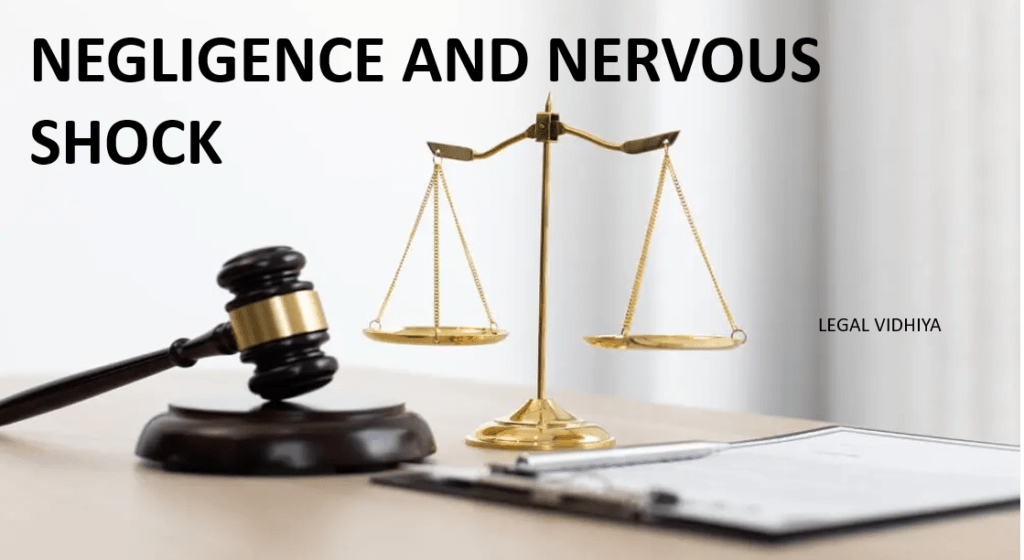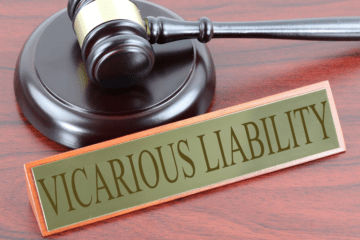
This article is written by Karishma Arora of National Law University, Odisha, an intern under Legal Vidhiya
ABSTRACT
This passage provides an overview of the intersection between negligence and nervous shock in tort law. It begins by defining tort law as addressing civil wrongs and offering remedies for harm caused by others. Negligence is explored, with an emphasis on the essentials of duty, breach, and resulting harm, using the case of Stevenson v. Donoghue as an example. The discussion extends to negligence as a crime, particularly criminal negligence and its defences under both federal and state laws, referencing Section 304A in the Indian Penal Code. The passage then delves into nervous shock, a relatively recent legal concept, outlining its elements such as chain of causation, foreseeability, and proximity, supported by relevant cases like Bourhill vs Young. The abstract encapsulates the key points of negligence and nervous shock in tort law, emphasizing legal principles, case examples, and the evolving nature of these concepts.
KEYWORDS:-
Negligence, Nervous Shock, Tort Law, Stevenson v. Donoghue, Criminal Negligence, Section 304A IPC, Foreseeability, Proximity, Bourhill vs Young
INTRODUCTION
In tort law, negligence and nervous shock play major roles. The number of cases waiting in courts pertaining to medical negligence alone is over 700[1], meaning that the overall number of cases pertaining to negligence can only be approximated. Numerous instances involving nervous shock are also pending in the courts.
Although tort law is complex, it is possible to understand. The word “tort” originates from the Latin word “tortum,” which is the English word for “wrong.” A key component of the legal system that deals with civil wrongs and offers remedies to people hurt by the wrongdoings of others is the tort law. Its cases include a wide range of topics, from negligence and defamation claims to personal injuries and property damage. Fundamentally, the goals of tort law are to make up for the suffering that victims have suffered and to discourage other people from committing the same wrongdoing.
If we try to explain negligence, according to jurisprudential concepts there is no proper definition of negligence. It is believed that eminent jurists and influential rulings have given different interpretations to negligence. The Supreme Court ruled in the case of Jacob Mathew noted: Negligence is defined as the failure to perform an act that a prudent and sensible man would perform, or the performance of an act that a sensible man would not perform, guided by the considerations that typically govern the conduct of human affairs. Neglecting to use ordinary care and skill towards someone for whom the defendant owes it is deemed actionable negligence. The plaintiff could have incurred injury to himself or his property as a result.
Nervous shock :- This area of law is relatively new. It offers comfort to those who might suffer from physical harm caused by the nervous shock from what they have seen or heard, rather than from an impact such as a stick, bullet, or sword. In Victorian Railway Commissioner v. Coultas, the Privy Council’s Judicial Committee ruled in 1888 that injury resulting from a shock that entered the eye lenses or ear drums without direct contact was not recognized. They believed that a physical impact or something similar was necessary for an action to be sustained. However, shortly after the decision mentioned above, it was discovered that nerve shock injury—which is independent of any physical impact—was identified. The antiquated notion that the law should only consider physical harm brought about by actual impact has been abandoned, and it is now widely acknowledged that injuries caused by shock that are received through the eye or ear without physical contact qualify for legal action.[2]
NEGLIGENCE
We have learned in the introduction part what negligence is all about, know the answer to the question how negligence is also a crime going to be given.
ESSENTIALS OF NEGLIGENCE
The plaintiff in a negligence case must establish the following elements:
- The plaintiff is entitled to a duty of care from the defendant;
- defendant violated that obligation;
- As a result, the plaintiff experienced harm. [3]
The renowned case of negligence is Stevenson v. Donoghue (1932) A.C. 532. The sail in the bottle case is another name for this case. The plaintiff in this case, Donoghue, went to a café in Paisley with a friend. They place an order for a bottle of ginger beer and some refreshments. Stevenson, the defendant, was the one who made the ginger beer that was served in the opaque, dark glass bottle. The plaintiff’s friend noticed a decomposing snail floating out of the bottle as she was pouring the last of the beer into her glass. The plaintiff experienced gastroenteritis and shock as a result of eating the snail’s contaminants and this nauseating location. The defendant was found to be liable by the court because he was under a duty under law to use reasonable care in ensuring that the goods are delivered free from defects that could endanger anyone’s health.
NEGLIGENCE AS A CRIME
When someone ignores a known or clear risk, another person’s life, safety or, it is referred to as criminal negligence. This behaviour is classified as recklessness by both federal and state courts when it differs noticeably from what an average person would do in the same situation.
Criminal negligence thresholds establish culpability for some offenses. The crime of unintentional manslaughter serves as one illustration. In most states, the prosecution must show that the defendant behaved with criminal carelessness even when the victim’s death was an accidental result of their actions.
Defence attorneys use a variety of legal techniques to refute claims of criminal negligence. These include demonstrating that:
1. The accused did not knew the act would put others in danger;
2. The accused did an act because of an error or accident; and
3. The accused behaved with due caution.
The above highlighted part is also the defences used in negligence.
Section 304A covers negligence in IPC
304A. Causing death by negligence. –Whoever causes the death of any person by doing any rash or negligent act not amounting to culpable homicide, shall be punished with imprisonment of either description for a term which may extend to two years, or with fine, or with both.[4]
CASES
Lord Macmillan explained the reasonable man’s criterion of foresight in Glasgow Corporation case
The reasonable man’s standard of foresight functions as a kind of impersonal litmus test. It does away with the individual equation and is independent of the characteristics of the person whose behaviour is being examined. Some individuals are too cautious by nature and think there are lions on every street. Stronger temperaments can make it impossible to foresee dangers or to disregard them with casualness. Although the reasonable person is thought to be immune from both overconfidence and over appreciation, there is a method in which the reasonable man’s standard of care incorporates subjectivity into its application. The judge must nonetheless ascertain what a reasonable person would have concluded given the particular circumstances and what the party attempting to try to find liability should have thought in light of those facts. There is space for a range of opinions here. What is implausible to one judge may appear plausible and normal to another. [5]
Mayi Gowda v. State of Karnataka,
Following to buying ticket, complainant and his 5 children had a joyride on an elephant in the Mysore Dasara Exhibition Ground on October 7, 2002, at around 8 p.m. The elephant grew agitated during the busy hour and started to charge ahead after taking several circles as the complainants and other people were attempting to descend the cradle. The party making the complaint was flung to the ground; as a result, he sustained severe injuries that led to complete loss of both eyes’ vision. He worked as a medical professional. He stated payment of 9,90,000 rupees. the female elephant has been participating in these rides and festivals for 13 years. she had also participated in movie shoots, religious events, and V.I.P.s. It was decided that the people who had planned the pleasure ride on the opposite side had not been negligent. The elephant’s strange and unpleasant behaviour was an accident; thus, the complaint was rejected.[6]
NERVOUS SHOCK
Nervous shock is a part of negligence and is comparatively of recent origin.
ELEMENTS
It is important to understand the basic elements to understand about nervous shock claims in tort law. To establish a successful case under nervous shock, the following elements must be present:
Chain of Causation: In this, the claimant’s burden in a nervous shock claim extends To demonstrating that it was due to the defendant’s negligent act or omission that there was a psychiatric injury. There must exist a direct link between the actions of the defendant and the mental or emotional harm suffered by the claimant. This essential element mandates a connection between the plaintiff’s nervous shock and the consequences resulting from the defendant’s wrongful act.
For instance, there is a tragic accident where a bus hits a bike due to the defendant’s reckless
and rash driving. The claimant is a bystander who witnesses the horrifying accident and
consequently, suffers from emotional distress. To establish a shock claim, it should be
proved that the claimant’s emotional suffering was a direct consequence of observing the
accident which was caused due to the defendant’s negligence. A clear connection has to be
established between the defendant’s wrongful act and the claimant’s emotional harm.
Foreseeability: The harm suffered through the claimant should be clearly foreseeable as a result of the defendant’s act or omission thereof. This implies that a reasonable person, if put in the shoes of the defendant, would have seen that their actions would result in mental or emotional harm. Foreseeability is an important element as it establishes a link between the defendant’s actions and the claimant’s emotional injuries.
Proximity: It is a fundamental concept in nervous shock claims which refers to the
relationship between defendant’s action and the mental harm suffered by the claimant.
Proximity plays an important role in determining the validity of nervous shock and also to
determine the extent to which the defendant’s action was responsible for causing emotional
harm to the claimant. A claimant may be required to establish physical closeness to the
incident. Being in proximity to the accident or the traumatic event is an important aspect of proving nervous shock. The claimant should also have experienced the incident in a timeframe closely related to when it happened. It is also to be noted that mental shock resulting from being informed by the incident through a third party does not meet the proximity criteria. There should be personal presence or immediate proximity to the traumatic event.
CASES
The case of Bourhill vs Young
Places emphasis on the importance of foreseeability and proximity to the accident. Here, due to negligently driving his motorcycle, the defendant caused a collision with a car and suffered serious injuries. During the crash, the plaintiff- who was 8 months pregnant- was 50 feet away from the location of the accident and was exiting a tram. She went to the scene of the accident later where she witnessed the aftermath of the accident and saw blood on the road. Later, she gave birth to a still born child which she claimed happened due to the nervous shock she suffered as an aftermath of witnessing the accident. However, it was ruled that the defendant was not liable to compensate the plaintiff for any psychiatric harm. This was because it was nor foreseeable that the claimant would suffer through mental harm due to the defendant’s actions. It was also ruled that the plaintiff’s proximity to the scene of crash was not sufficient to establish a duty of care towards her.[7]
CONCLUSION
Overall, the passage illuminates the dynamic landscape of tort law, showcasing its breadth from negligence to the evolving contours of nervous shock. It underscores the jurisprudential nuances, drawing on legal principles and case analyses to explicate the essentials of negligence and the intricacies surrounding claims for emotional distress. This comprehensive exploration provides a holistic understanding of the interplay between negligence and nervous shock within the legal framework, underscoring their significance in addressing civil wrongs and ensuring just remedies for those harmed by the acts or omissions of others.
[1] Over 700 negligence cases pending: medical council sets up panels to deal with them, The Indian Express (Jul. 7, 2018), https://indianexpress.com/article/cities/pune/over-700-negligence-cases-pending-medical-council-sets-up-panels-to-deal-with-them-5249383/ (last visited Dec 6, 2023).
[2] Law of Torts by R.K Bangia, studylib.net, https://studylib.net/doc/25885001/law-of-torts-by-r.k-bangia (last visited Dec 5, 2023).
[3] Id.
[4] Indian Penal Code, 1860, It is expedient to provide a general Penal Code for india (1860), http://indiacode.nic.in/handle/123456789/2263 (last visited Dec 6, 2023).
[5] Law of Torts by R.K Bangia, supra note 2.
[6] Mayi Gowda vs State Of Karnataka And Ors. on 20 December, 2002, https://indiankanoon.org/doc/1466321/ (last visited Dec 6, 2023).
[7] Bourhill v Young Case Summary 1943 – Law Planet – Legal News, Law Updates & Law Exams Preparation, https://lawplanet.in/bourhill-v-young-case-summary-1943/ (last visited Dec 6, 2023).
Disclaimer: The materials provided herein are intended solely for informational purposes. Accessing or using the site or the materials does not establish an attorney-client relationship. The information presented on this site is not to be construed as legal or professional advice, and it should not be relied upon for such purposes or used as a substitute for advice from a licensed attorney in your state. Additionally, the viewpoint presented by the author is of a personal nature.




0 Comments